
Sparidae is a family of ray-finned fishes belonging to the order Spariformes, the sea breams and porgies, although they were traditionally classified in the order Perciformes. They are found in shallow temperate and tropical waters around the world and are demersal carnivores.
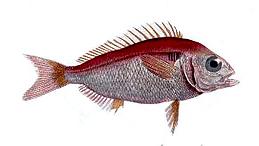
Pagellus is a genus of marine ray-finned fish belonging the family Sparidae, which includes the seabreams and porgies. These fishes are found in the eastern Atlantic Ocean, the Mediterranean Sea and the western Indian Ocean.

The red porgy, or common seabream, is a species of marine ray-finned fish in the family Sparidae. It is found in shallow waters on either side of the Atlantic Ocean, being present on the western coast of Europe and the Mediterranean Sea as well as the eastern coasts of North and South America and the Caribbean Sea. It feeds on or near the seabed and most individuals start life as females and later change sex to males.

The common dentex is a species of marine ray-finned fish belonging to the family Sparidae, which includes the seabreams and porgies. This species is found in the northeastern Atlantic Ocean and the Mediterranean Sea. It is a highly valued food fish and is an important target species for fisheries and the population has shown large declines leading the International Union for Conservation of Nature to classify its conservation status as Vulnerable.
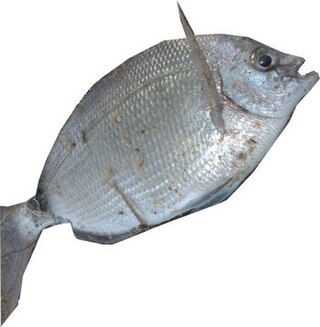
The spottail pinfish is an ocean-going species of fish in the family Sparidae. It is also known as the spottail seabream or spottail pinkish porgy. Along with other members of their family, Spottail pinfish are occasionally eaten and considered by some to be a panfish.

The saddled seabream, also called the saddle bream or oblade, is a species of ray-finned fish belonging to the family Sparidae, which includes the seabreams and porgies. It is the only species in the monospecific genus Oblada. This species is found in the Eastern Atlantic Ocean. It is an important food fish within its range.

Diplodus sargus, the white seabream or sargo is a species of marine ray-finned fish belonging to the family Sparidae, which includes the seabreams and porgies. This fish is found in the eastern Atlantic Ocean and in the Mediterranean Sea. It is a target species for commercial fisheries and is grown in aquaculture. D. sargussensu lato was formerly thought to be a widespread species in the eastern Atlantic and western Indian Oceans but the taxa outside of D, sargussensu stricto are now recognised as valid species and are part of the D. sargus species complex.

Diplodus is a genus of marine ray-finned fish belonging the family Sparidae, which includes the seabreams and porgies. These fishes are found in the Atlantic Ocean, the Mediterranean Sea and the western Indian Ocean.
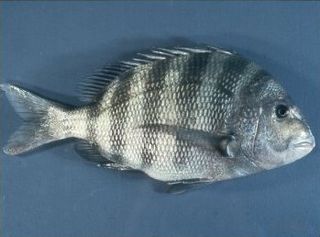
Archosargus is a genus of marine ray-finned fishes belonging to the family Sparidae, the sea breams and porgies. These fishes occur in the Western Atlantic and Eastern Pacific Oceans.

Diplodus vulgaris, the common two-banded sea bream, is a species of marine ray-finned fish belonging to the family Sparidae, which includes the seabreams and porgies. This species is found in the northeastern Atlantic Ocean and the Mediterranean. It is an important species for fisheries and is grown in aquaculture.

Acanthopagrus is a genus of marine ray-finned fishes belonging to the family Sparidae, the sea breams and porgies. The fish in this genus are found in the Indian and western Pacific Oceans.

Acanthopagrus berda, the goldsilk seabream, sly bream, picnic seabream, black sea bream, black porgy, picky bream, silver bream or river bream, is a species of ray-finned fish belonging to the family Sparidae, the sea breams and porgies. This species is found in the Indian Ocean.

Dentex is a genus of marine ray-finned fishes belonging to the family Sparidae, which includes the seabreams and porgies. The fishes in this genus are found in the eastern Atlantic Ocean and the eastern Indian and Western Pacific Oceans.

Cheimerius is a monospecific genus of marine ray-finned fish belonging to the family Sparidae, the seabreams and porgies. The only species in the genus is Cheimerius nufar, the santer seabream, santer or soldier, of the Indian Ocean.
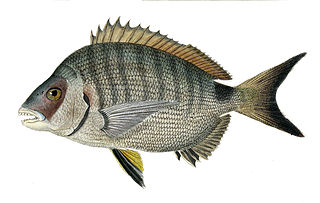
The St. Helena white seabream is a species of marine ray-finned fish belonging to the family Sparidae, which includes the seabreams and porgies. This fish is endemic to the island of Saint Helena in the southern Atlantic.
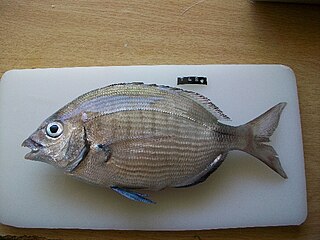
Diplodus capensis, the Cape white seabream or blacktail seabream, is a species of marine ray-finned fish belonging to the family Sparidae, which includes the seabreams and porgies. This fish is found around the coasts of Southern Africa.

Diplodus annularis, the annular seabream is a species of marine ray-finned fish belonging to the family Sparidae, the family which includes the seabreams and porgies. This species is found in the Eastern Atlantic Ocean and Mediterranean.
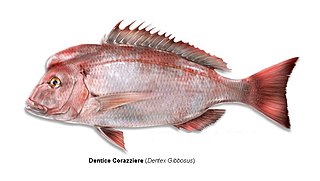
The pink dentex is a species of marine ray-finned fish belonging to the family Sparidae, a family that includes the seabreams and porgies. This species is found in the temperate and tropical waters of the eastern Atlantic Ocean and the Mediterranean Sea.

Evynnis is a genus of marine ray-finned fishes belonging to the family Sparidae, which includes the seabreams and porgies. The genus comprises 4 species, 3 in the Western Pacific Ocean and 1 in the Eastern Atlantic Ocean.

Evynnis cardinalis, the threadfin porgy or cardinal seabream, is a species of marine ray-finned fish belonging to the family Sparidae, which includes the seabreams and porgies. This fish is found in the Western Pacific Ocean off the coasts of Eastern Asia. It is an important food fish but is classified by the IUCN as Endangered.




















